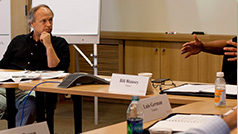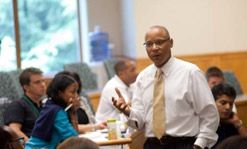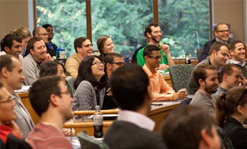The Pandemic as a Catalyst: Rapid Transformation for Future Success in Media and Healthcare
November 24th, 2020Topics: Communications Customer Future of Work Marketing / Sales Operations

On October 23, 2020, the Center for Digital Strategies (CDS) and Center for Health Care (CHC) hosted a pilot “Digital Safari,” bringing together CDS and CHC Fellows with media and healthcare executives to discuss and debate the challenges and opportunities practitioners faced this year as a result of the global COVID-19 pandemic. Students heard about digital strategies deployed to combat those challenges and how companies have identified unique opportunities during this crisis to ensure survival. The event brought together a diverse array of executives across industry, which was made possible due to the amazing Tuck network.
Media and healthcare companies are lightyears apart in terms of business models and strategies. But our day revealed recurring themes that highlighted the importance of flexibility, innovation, and comfort in ambiguity during times of uncertainty—lessons that every business leader can learn from. These concepts align with how we analyze the widespread impact of digital strategies, and how in the face of unprecedented challenges, companies must demonstrate these qualities to lead.
The Digital Safari introduced students to executives at Accenture, ScreenVision Media, ESPN, Force Therapeutics, Parsley Health, and a Tuck alumnus who teaches at UCLA Anderson, having recently retired as an EVP from Universal Studios.
Flexibility
In March, as live sporting events shut down overnight, ESPN lost its core source of content production, creation, and distribution. Needing to quickly react in order to meet contractual (affiliate) agreements with their partners, ESPN looked to less traditional sports that were not as heavily impacted by COVID-19. Enter Kevin Lopes (Director of Business Development) and Cliff Shoemaker (Sr. Manager of Digital Programming). For years, these two (along with their lean teams) were steadily building up ESPN’s expertise and strategy in eSports production. In a pinch, Kevin and Cliff’s teams helped deliver unexpectedly new content to audiences craving competitive entertainment.
How did Kevin and Cliff stand-up such a wide array of content in such a short amount of time? At the risk of over-simplifying an Ecosystem Strategy lesson, the minimal viable ecosystem for eSports was present, and timing that had previously eluded ESPN’s eSports leadership team was now aligned with the circumstances. That quick pivot exposed ESPN audiences to original content while ESPN devotees anxiously awaited the debut of the Chicago Bulls docuseries, The Last Dance, and of course, the return of live sports. The experiences that Kevin and Cliff shared about those days leading up to the eSports programming launch highlighted the importance of creating and maintaining relationships, being agile, and successfully taking action in times of disruption.
Innovation
ScreenVision Media, the leader of in-movie theater advertising, was forced to find additional revenue streams when movie theaters shuttered across the country. In analyzing the predicament they were in, they focused on their core competency — their sales force — to generate revenue on other “profitable screens,” such as drive-in theaters and electric car charging stations.
John Partilla (CEO) and Andrew Gyves (EVP) explained their approach to sales, specifically how they focus on growing their business, especially in a mature industry. For ScreenVision, the threat of a major business disruptor has always been eminent with the decline of traditional linear TV. The company’s platform to diversify its business model and expand beyond the profitable screens at movie theaters was essential for survival to achieve financial targets. ScreenVision’s actions during the pandemic followed its four-pronged approach to succeeding in a pandemic: survive, innovate, develop, and maintain. This impactful example of leadership in action, showed us that decision-making in crisis requires creativity, flexibility, and persistence.
Before we ended our chat, John shifted topics and called for us to reflect and “dig deep,” given that we will be in leadership positions in our careers, to understand how we as leaders are built, to focus on what is truly important, and to pursue a journey that aligns with those perspectives. What do you consider important and how does your career align with that perspective?
Comfort in Ambiguity
COVID-19 has been the biggest test for business decision-making in the face of ambiguity. Accenture highlighted how historically catastrophic events gave rise to new norms and values in society, catalyzing change and forcing (hopefully) calculated action. Our guest, Rob Harles (Managing Director) led us to reflect: Has the pandemic simply forced change in the media industry that has long been overdue? Are the changes made fixes to survive now or will they evolve to solutions that actually help media companies meet changing consumer needs?
In our conversation with Doug Neil T’91 (Instructor at UCLA Anderson and former EVP at Universal Studios), we discussed the future of the streaming industry, using Quibi as a case study for what can and may not work. Doug emphasized that start-ups burn through cash with innovative test-and-learn strategies to tackle ambiguity. This mindset inherently yields an agile process, allowing them to test new products first and worry about profits later. As we saw with Quibi, this has limited runway when not executed according to consumer needs and is definitely not an approach incumbents in media have dared try.
As we reflect on the forced changes in media, we can only begin to think how these lessons are even more salient and crucial for success in healthcare amidst the dynamics of 2020. Both digital media and telehealth firms have had to be flexible, dig deep to find creative executional strategies, and find ways to innovate to combat ambiguity.











